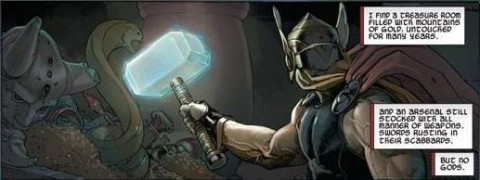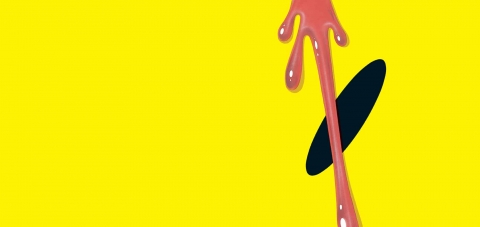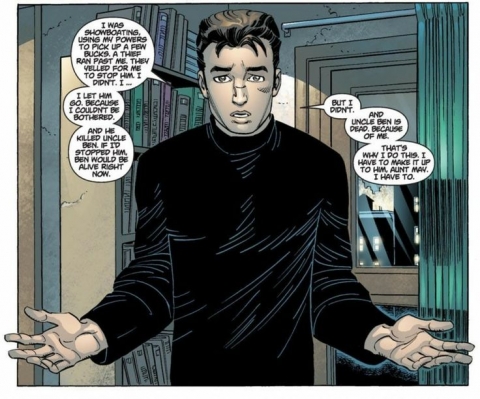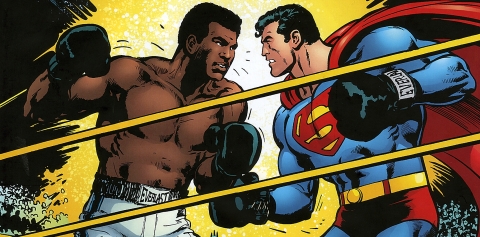52 weeks. 52 different writers. 2 trade paperbacks or hardcovers a week. Each week I’ll take a look at a different writer and read two different collected editions from within that person’s repertoire to help in the examination of their work. The beautifully bearded beast of a man named Jason Aaron is in the spotlight this week. Did I mention he’s got a beautiful beard?
Jason Aaron
Jason Aaron is one of the hottest writers in the game today. He has become one of Marvel’s heavy hitters penning the likes of Wolverine and The X-Men, Star Wars and Thor. Aaron began his run on Thor back when Marvel did a soft relaunch of many of their titles, known as Marvel Now! His run with the character has gained much acclaim from fans and critics alike but Aaron’s time with Thor hasn’t been entirely smooth. Last Summer, Marvel announced that Thor would not be wielding his trusty hammer, Mjolnir, anymore and instead would be replaced with a new female lead. As is the usual in comics, fans were thrown in an uproar over the change in gender only to be quickly silenced by the quality of the story being told. The title is a consistently strong seller now and is still getting plenty of love from fans. Today we take a look at the very start of Jason Aaron’s Thor run which still features the titular character as a male.
Thor: God of Thunder Volume 1 – The God Butcher
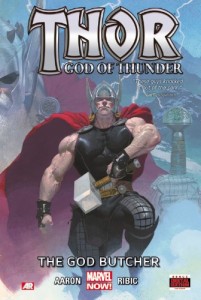 Thor, the Prince of Asgard and the God of Thunder, unexpectedly stumbles upon the discovery of several deceased Gods. To make matters worse, not only are these Gods dead but Thor finds out they’ve been murdered in cold blood by a being who has plagued him for centuries. Gorr, the Butcher of Gods, encountered a young and brash Thor hundreds of years ago as he sought out to create a world without any Gods at all. Thor races to uncover Gorr’s final gambit as he is assaulted in the past, present and future by the sinister villain.
Thor, the Prince of Asgard and the God of Thunder, unexpectedly stumbles upon the discovery of several deceased Gods. To make matters worse, not only are these Gods dead but Thor finds out they’ve been murdered in cold blood by a being who has plagued him for centuries. Gorr, the Butcher of Gods, encountered a young and brash Thor hundreds of years ago as he sought out to create a world without any Gods at all. Thor races to uncover Gorr’s final gambit as he is assaulted in the past, present and future by the sinister villain.
One of the things that will strike upon a first reading is the style of narration which all ties back to that folklore feel I mentioned a few sentences ago. Jason Aaron gets so much right here as he blends together a healthy balance of dialogue and captions to tell the story in a manner that is reminiscent of myths. Aaron will use a character’s dialogue to transition into a caption that hammers (no pun intended) home an ancient feeling. For example Thor will say something like “Get back thy or face my might” to only then be followed up by a caption that reads “…cried Thor with crackling swing of Mjolnir!”. It is very similar to how you’d read a myth, with the character speaking through an action as it is demonstrated. To a further point that connects back to the dialogue, the way Thor speaks is perfect for not only the character but also the reader. He speaks in Middle English dialect with plenty uses of words like “thy” but still keeps Thor’s way of speaking modernized enough that it won’t turn off people who feel bogged down by older styles of speaking. This isn’t like clawing your way through something like Mary Shelley’s “Frankenstein” or a Shakespearean play, choosing to keep it accessible for readers without dumbing it all down at the same time. For people who enjoyed books like Frank Miller’s “300” and appreciated the narrating in it, you’ll eat up Jason Aaron’s time with the character of Thor.
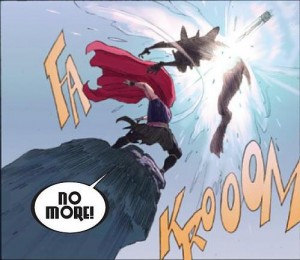 Thor: The God Of Thunder reads as much like it is a true piece of Norse mythology as it does like a comic book. The style in which this book done is immediately striking in a positive manner as it blends together folklore with comic related goodness. Visually striking (yeah, props to Esad Ribic are rightfully deserved for the art in this one) as well as richly written, Thor: God Of Thunder is a book that, although well loved and praised, deserves even more of praise than what it gets. The story blends together the timelines of three different Thors, one from the past, the present and the future. In telling the story this way you get an even greater sense of Norse mythology as the past timeline unfolds seemingly in tandem with the present timeline, pacing itself out to cap off when the present Thor story climaxes as well. In these three story lines you get a glimpse at the past to define what’s happening in the present, a sense of urgency to hook you into the main story, and finally a sense of despair yet hope to keep you compelled for what’s to come in the future. Together, the three stories compliment each other perfectly, playing out at a satisfying pace and elevating the experience as you carry on.
Thor: The God Of Thunder reads as much like it is a true piece of Norse mythology as it does like a comic book. The style in which this book done is immediately striking in a positive manner as it blends together folklore with comic related goodness. Visually striking (yeah, props to Esad Ribic are rightfully deserved for the art in this one) as well as richly written, Thor: God Of Thunder is a book that, although well loved and praised, deserves even more of praise than what it gets. The story blends together the timelines of three different Thors, one from the past, the present and the future. In telling the story this way you get an even greater sense of Norse mythology as the past timeline unfolds seemingly in tandem with the present timeline, pacing itself out to cap off when the present Thor story climaxes as well. In these three story lines you get a glimpse at the past to define what’s happening in the present, a sense of urgency to hook you into the main story, and finally a sense of despair yet hope to keep you compelled for what’s to come in the future. Together, the three stories compliment each other perfectly, playing out at a satisfying pace and elevating the experience as you carry on.
For the overall story the only true downside is the fact that this volume doesn’t contain the full story. You’re left with a delicious cliffhanger that will guarantee you come back for more. After reading those two sentences you’re probably saying “Well how is that really a true downside?”, and to that all I have to say is “Exactly!”. If you want just a one and done story by Thor, this won’t be your cup of tea but if you want something that feels epic and will have you buying multiple volumes thereafter than you should go buy this book right away.
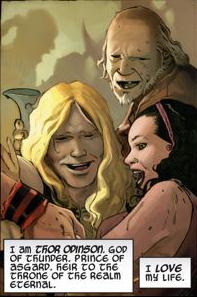 This is a very Thor-centric comic which shouldn’t be a surprise considering his name is on the front of the book. Thor is obviously the main focus of this collection of stories and due to the fact that there are two other Thors beyond the one from the present timeline in this story, there isn’t much room for the development of a secondary cast. Now in most instances, going five issues without developing even the slightest hint of some secondary characters would be weird but again, with three Thors in one comic it works surprisingly well. Jason Aaron doesn’t have the time to build up other characters because he spends so much time playing architect with Thor’s destiny because of the multi-Thor approach. These three Thors are so widely distinct from each other but still house a similar personality traits that all three of them carry which makes it so much fun to watch how they all deal with the same threat at varying degrees of difficult while being centuries apart from each other.
This is a very Thor-centric comic which shouldn’t be a surprise considering his name is on the front of the book. Thor is obviously the main focus of this collection of stories and due to the fact that there are two other Thors beyond the one from the present timeline in this story, there isn’t much room for the development of a secondary cast. Now in most instances, going five issues without developing even the slightest hint of some secondary characters would be weird but again, with three Thors in one comic it works surprisingly well. Jason Aaron doesn’t have the time to build up other characters because he spends so much time playing architect with Thor’s destiny because of the multi-Thor approach. These three Thors are so widely distinct from each other but still house a similar personality traits that all three of them carry which makes it so much fun to watch how they all deal with the same threat at varying degrees of difficult while being centuries apart from each other.
Now although there aren’t many characters aside from Thor in this volume, there are still some interesting additional cast members who do impact the story, including the villain, Gorr. Gorr, Butcher of Gods, in a character that doesn’t get much definition beyond just being a sinister individual. You understand that his mission is to eliminate all of the Gods so that he can exist in a realm without Gods but even then you don’t really get to understand his true motivations. Again, at first glance you see a motivation (to exist in a realm without Gods) but you don’t get why that is his motivation, never getting to see what makes him tick. Gorr is just kind of “there” for the story at first, he is present and making Thor’s life difficult, but as you go along you see his plans involve so much more than just Thor. It would’ve been great to have some more insight into the villain in this volume but it appears as though Aaron poised himself to build Gorr into something truly treacherous as…wait no, that’d be spoilers. Let’s just say that Jason Aaron leaves room for Gorr to be developed at a future juncture.
Collects: Issues 1-5 of Thor: God Of Thunder
Best Character: Thor of the Past
Best Lines of Dialogue/Caption: “We have no Hall of Blunt Instruments, I’m afraid. Nor Hall of Thunder, unless you count the lavatory when there are troll gods about.” – The Librarian
Best Scene/Moment: Thor versus the Blackened Beasts in the future – Issue 3
Best Issue: Issue 4. The fourth issue in this series stands out from the rest of the pack simple because it is the climax of entire collection and all of the Thor timelines. In the past you discover why that timeline is so important to developing the character of Gorr, in the present Gorr’s true motivations are revealed and in the future you see exactly where this series of stories will be heading. It blends together the action with the drama so beautifully as this is the point where you’ll care about the story the most and likely decide that you’ll be sticking around with Jason Aaron’s work on Thor for the long run.
Why You Should Read It: Jason Aaron’s work on Thor speaks volumes about how much he understands and cares for this character. He looks at the character from three different points in time and absolutely nails his interpretation of each. You’ve got a young, arrogant Thor from the past, a hardened, wise yet fun Thor of the present and a battle hardened and fickle Thor of the future. Tack that on with the fact that Aaron truly is writing an epic here (no I’m not misusing the word like it is most of the time, this story really feels like an epic in many sense) that blends together mythology with what makes comics fun and this one is a winner all over. Come enjoy how masterfully Aaron shifts storytelling gears with dialogue and captions with a strong, character-centric tale.
Scalped: Volume 1 – Indian Country
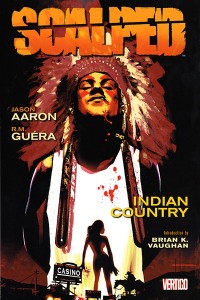 If there is one style of comics that Jason Aaron excels at writing for, it’s crime. In recent years, Jason Aaron has penned both Southern Bastards and Scalped, two crime books set in distinct settings but tell vastly different stories. Southern Bastards has just recently launched, having published six issue while Scalped had a run of sixty. Aaron pulls out all the stops when it comes to these crime stories, making them sick, gut churning experiences that you only put down so that you can go out and buy the next issue or trade. Now admittedly, I had a very tough time trying to choose which story to sit here and talk about today. Southern Bastards is more recent of a story making it more culturally relevant but ultimately I decided on Scalped for two simply reasons. First, it’s a great series. Secondly, my goal is to push people towards this book if they’ve already read Southern Bastards and loved it. Trust me, as great as Southern Bastards has been thus far, Scalped is better and that’s say something considering how good Southern Bastards is.
If there is one style of comics that Jason Aaron excels at writing for, it’s crime. In recent years, Jason Aaron has penned both Southern Bastards and Scalped, two crime books set in distinct settings but tell vastly different stories. Southern Bastards has just recently launched, having published six issue while Scalped had a run of sixty. Aaron pulls out all the stops when it comes to these crime stories, making them sick, gut churning experiences that you only put down so that you can go out and buy the next issue or trade. Now admittedly, I had a very tough time trying to choose which story to sit here and talk about today. Southern Bastards is more recent of a story making it more culturally relevant but ultimately I decided on Scalped for two simply reasons. First, it’s a great series. Secondly, my goal is to push people towards this book if they’ve already read Southern Bastards and loved it. Trust me, as great as Southern Bastards has been thus far, Scalped is better and that’s say something considering how good Southern Bastards is.
Dashiel “Dash” Bad Horse returns to the reservation he grew up on after leaving home at the age of thirteen. The reception of Dash’s return is far from warm as plenty of old wounds are re-opened. Family, friends and lost lovers seemingly come out of the every hole in this run down place to judge and ridicule the man who disappeared all those years ago. A man with a mean streak and one hellava temper, Dash is recruited on to the reservation’s special police force by his wealthy “uncle”, Red Crow, who is stirring up controversy with the opening of a ninety seven million dollar casino on the “rez”.
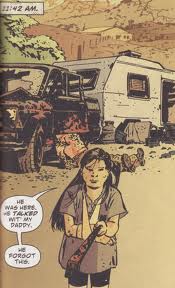
Scalped is a fast, dark, brutal and disturbing Native American crime story that will rattle your bones at any opportunity when it’s given. When an opportunity isn’t given, Scalped just takes one anyway and doesn’t give a damn whether or not you were prepared for it. Scalped has more grit to it than sandpaper, choosing to rough you up at every step along that way. It is most readily comparable to something like Sons of Anarchy in the regards to it being a slightly unconventional crime drama. The biggest difference between the two though is that Scalped sets itself out in front of seven seasons of network television with five simple issues.
The story behind Scalped is one that will keep you guessing with every turn of a page, never aware of what shocking blow will come next. Just when you think you’ve found your balance and can settle in, Jason Aaron rips the rug out from underneath you and changes the path that the story is on. There is absolutely no way you’ll guess what comes next because those cliffhanger moments always seem to come out of left field, with none more surprising than the reveal placed so suddenly at the end of the gripping first issue. This reveal sets the tone for the entire story going forward, as you sit wide eyed and with great attention to detail.
For the dialogue, Aaron sprinkles in Native American terminology with modern English and tons of swearing. This isn’t a comic that translates the native phrases for you, instead choosing to interject them in between English words, typically during dramatic moments. This heightens the effectiveness of these words that, although you don’t understand them, are given extra weight because of the way they hit and are said. In the heat of an argument Dash and his mother will be speaking English only to fire off with a Native line and then transition back to English. You won’t have one clue what she just said but you get the feeling there was plenty of venom in the phrase. The only thing that truly hampers the dialogue is the excessive use of swear words throughout the entire story, being used to the point where you become numb to the cursing. It seems rare to not see a swear word popping up in at least every other word bubble because of how excessively these words are used. The overuse of these words just wears you down at some points, leaving you hoping for something more dynamic to happen with the dialogue. In defense of the dialogue though, this feels pretty spot on with how these people would actually talk. They’re poor, impoverished, crime stricken individuals, all of whom seem undereducated. It makes sense for these characters to speak so freely with such harsh terms.
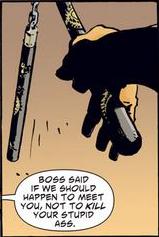
As for characters there are plenty of them who all come across differently and have their own agenda. The main character, Dashiel Bad Horse, is a badass. There’s just no other way to say it. He is a nunchuck wielding, ass-kicking, take no nonsense badass. Dash has more than a few skeletons in his closet though and it is these skeletons that are what give this story some real heft. You never really know who this character is or what his agenda is even when it is clearly placed out in front of you. Even though the character seems like a hardened, ruthless man at times, Aaron manages to pull back a few layers of the character and show he is compassionate but displays it in an unconventional way. This is mostly displayed through the relationship dynamic shared between Dash and Red Crow’s daughter, Carol. The two were teenager sweethearts once upon a time but that all changed when Dash left the “Rez” at the age of thirteen. Carol harbors resentment towards Dash because of this but Dash still shows he cares for Carol in a few unconventional ways.
The big bad, Dash’s uncle Red Crow, has his personality set firmly from the first moment he appears, as we see him push Dash into a corner from which he can’t get out of easily. Red Crow is a wealthy and powerful man who always gets his way and isn’t afraid to get his hands dirty. Much like Dash, as the story carries on you see that there is so much more to Red Crow’s history as well but, unlike Dash, he seemingly lacks that subtle compassion and is fickle at heart. Red Crow is set up to be equally compelling as he is villainous in this first series of stories, giving you the desire to keep reading simply so that you can figure out what his true motivations really are. There are a few other cast members that care some weight like Dash’s mother, Gina. Gina is shown to be rather reckless and has, in Dash’s eyes, treated Dash unfairly his entire life. She was always fighting for a cause on the “Rez” instead of being there for her son which creates resentment issues between the two of them.
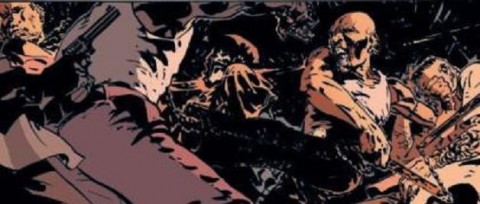
Collects: Issues 1-5 of Scalped
Best Character: Dashiel “Dash” Bad Horse
Best Line(s) Of Dialogue/Caption: “Look, kid, I like you, but you’re pressing your luck here. Now put that f**king gun away. And should you ever be stupid enough to pull one on me again, I suggest you fire quickly…and don’t f**cking miss.” – Red Crow
Best Scene/Moment: The ending to issue one that flips the entire story on it’s head. Yeah, you know what I’m talking about if you’ve read Scalped before.
Best Issue: Issue 2 – Indian Country Chapter 2. Choosing the best issue for a collection like this one is so hard because of the way the story pans out. It’s like picking your favourite episode from a season of a television show but every episode is so integral to the episode before and after it that to single it out instead of focusing on the whole storyline it pushes just seems unfair. Nonetheless, I went with Issue 2 because it rolls forward the dramatic ending from the first issue and has the story unfold in an interesting way. Even though the issue ends with a tense moment in the past that you can predict the outcome to, you still grit your teeth as you can never be too sure how cleanly everything will play out. The tension and drama present throughout this entire issue makes it a strong contender for the best issue in volume 1 of Scalped/
Why You Should Read It: Scalped is Jason Aaron at his absolute best. The dialogue is written in a way that makes sense for the characters, the characters themselves are all unique and wrapped up in some serious personal problems. The blend of drama and action is perfect here as I’d quickly recommend this book to anyone who is a fan of a show like “Sons Of Anarchy”. Just be forewarned that you’ll be running out to buy the other nine volumes of this series with haste because this book is better than anything you’ll see on television.

